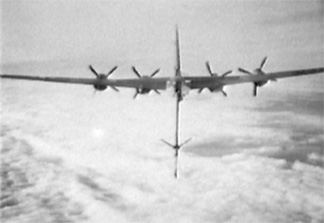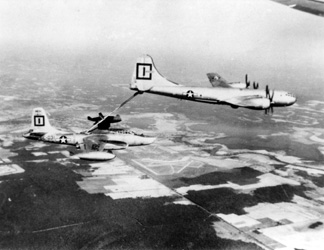Midnight Mission
|
||||||||
|
Photos from the author’s collection and Warren M. Bodie Page 5 of 7 Pages
|
||||||||
| To make Yokota, it was necessary to regain altitude for better fuel consumption or divert to Kimpo (K-14) in Korea. This was always tricky because of the time lost in getting our valuable cargo of intelligence back to the recon tech people in Japan and the exposure to potential intercept or ground fire while diverting across enemy lines.
The answer came from the copilot, when he delved into the fuel consumption charts and concluded that if we continued to gain altitude as fuel burned off, we would have just under 30 minutes reserve when hitting the high cone over Yokota. Decision time had arrived. Because we had been briefed for a ceiling at Yokota of 400 feet with 1/2 mile visibility upon our return, we had no spare fuel for a missed approach. Kimpo had fog, but required flying over enemy lines to get there. Weighing all the factors, the decision was made to continue on to our primary at Yokota. "Raven One, Mellow here do you read?" ... "Rog Mellow, Raven here, go." ... Raven One, be advised four escort friendlies approaching you astern 1 mile closing." "Oscar Sierra, clear to depart your escort, turn right heading 27 zero start climb to 35 zero angels, the Navy will now take over. Transfer 243.6 contact Beaver Control immediately for further instructions ... over." (At this point, our two escorting F-86s break formation, make a sweeping turn to the West as four jet F9F Navy Cougars, probably from the carriers Philippine Sea or Valley Forge cruising off the East coast of Korea, press in, taking up positions, two on each wing.) We are now approaching the east coast of Korea below the port city of Wonson. Altitude has been increased to 29,000 feet as more fuel is burned off. Tip tanks are now dry. Fuel is being consumed from internal wing tanks. Aerial refueling with a KB-29 would now come in handy to increase our reserve, however, no such luxury exists in the Far East Theater during our period of operation. (The RB-45C had an aerial refueling capability receiving from a flying boom, which the early KB-29s and KC-97s had provided on many occasions in the ZI.) |
||||||||
| "Raven One, Amber Leader here, flight of four F9Fs now in position doubling up on each wing. Cite your intentions and how far you desire escort over."
"Roger Amber Leader," I replied. "Be advised we intend to proceed to primary recovery base. How about carrying us to one zero zero miles on our present course, over." (Our heading was now on a direct course over the Sea of Japan to Yokota.) "Roger, can do," replied Amber One. As we proceeded on a southeasterly heading, my attention was drawn to a conversation on our backup frequency. I could clearly overhear Beaver Control directing our two F-86s toward an intercept of what turned out to be two MiG-15s. The MiGs had closed to within 15 miles of our tail position when they suddenly broke off the attack as a result of the F-86s being vectored toward them. Had the MiGs attempted a tail-firing chase on our RB-45, we would have had little defense. Even though the RB-45 had twin .50 caliber machine guns in the rear turret, they were fixed-mounted as a decoy. |
||||||||
 |
||||||||
|
with refueling boom extended. Photo Ctsy. Howard S. Myers |
||||||||
 |
||||||||
|
Photo Ctsy Harold Austin |
||||||||
| One was pointed up at a 45 degree angle, and the other down at a 10 degree angle. They could be fired by a toggle switch at the pilot's position, but not swiveled or aimed.
In the earlier model RB-45s, we carried tail gunners with a fully operational tail turret. This capability was later dropped in lieu of weight considerations and lack of confidence in the ability of the system to properly function, but at least we had the appearance of some defense in the rear. It was never disclosed during the Korean operation that we, in fact, did not have tail gunners manning those twin .50s. They offered some appearance of protection, even though, realistically, a fixed gun in the rear of any aircraft is a far cry from a "real" defensive threat. Page 1, Page 2, Page 3, Page 4, Page 5, Page 6, Page 7 To Go To — RB-45 Home — or — Miscellaneous RB-45 Home - Contact Us - Cold War Hist. - 91st SRS Hist. - Stardust 40 Mission Story |
||||||||